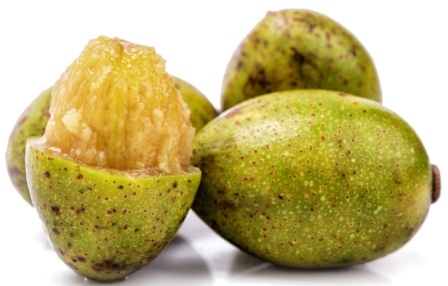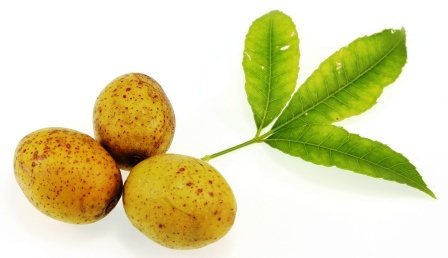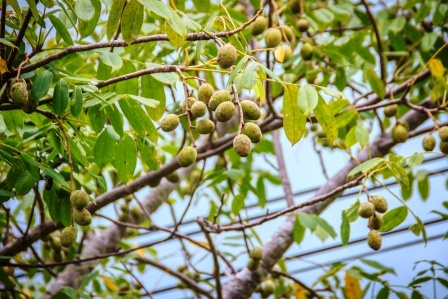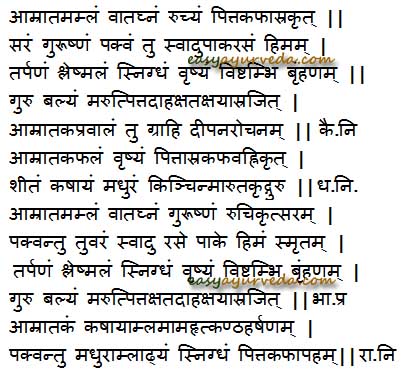Wild Mango (Hog Plum) – Spondias pinnata Uses, Research, Remedies
Amrataka- Spondias pinnata is a plant mentioned in Ayurveda for the treatment of diarrhea, irregular menstruation, anorexia, indigestion and nausea. Sponidas mangifera is also used synonymously.
Latin name- Spondias pinnata Kurz., Spondias mangifera
Family- Anacardeacea

Table of Contents
Vernacular names
Names in different languages:
Hindi name – Amra, Jungli aam. It is called amra in Hindi. But in Sanskrit, arma means mango.
English name – Wild Mango, Hog plum
Bengali name – Amda
Gujarati name – Abeda
Kannada name – Amatekayi
Malayalam name – Ambazhanga, Ampalam
Marathi name – Ambada
Tamil name – Mampulicci
Telugu name – Adavimamidi
Sanskrit synonyms
Sanskrit Synonyms of Amrataka:
Markatamra, Kapi Chuta, Kapi priya- Fruit is liked by monkeys in the forest
Madhuramla- The fruit is sweet and sour in taste
Rasadhya – Juicy fruit
Amla vatakah, Rasadhya, Varsha paki, Pittavaksha, Peethana
Tanu Ksheera, Balishaka, Amravata, Dusha Phala, Kapitana, Peetana,

Morphology
Morphology of Spondias pinnata:
This is a moderate sized glabrous thin foliaged deciduous tree, up to 20-25 m in height and 2.5m in girth with straight trunk and horizontal branches. The bark is thick surface light grey to grayish brown shallowly furrowed or cracked longitudinally and brittle in nature. The leaf is 30-45 cm long having 1-3 or 4 pairs of lateral leaflets in addition to the terminal. The leaves when crushed emit the smell of mango. The flowers are greenish white in color about 6m in size. The petals are 4-5 greenish white ovate oblong or acute 2.5-3.5mm long sub valvate and spreading. The fruits are fleshy drupes, green in color, have a smooth surface and measure about 3 cm in length and 2 cm in width. The fruits turn greenish yellow after ripening. The ripe fruits are mostly rounded to ovoid or ellipsoidal and are about 5 cm in length and 3.5 cm in diameter. There are couple of seeds inside the fruit. The seed is laterally flat 2.5-3cm long and 8 mm to 1cm wide and non-endospermic. From old trees, slimy resin can be obtained. The tree is found all over India in the deciduous forest.
Properties, part used, dosage
Medicinal properties of Hog plum:
Rasa (Taste) – Amla (Sour), Madhura (Sweet)
Guna (Qualities) – Guru (Heavy for digestion), Snigdha (Slimy)
Vipaka – Madhura (Undergoes sweet taste after digestion)
Veerya (Potency) – Sheeta (Cold)
Karma (Actions) – Vatapitta shamaka (reduces vitiated vata and pitta dosha)
Jangi Aam: Part used- Root, Bark, Leaf
Dosage-
Juice- 10 to 15 ml
Decoction- 40 to 50 ml

Chemical composition
Chemical composition of Spondias pinnata:
The fruit contains beta-amyrin, oleanolic acid and amino acids—glycine, cystine, serine, alanine and leucine; polysaccharides are also present. Aerial parts gave lignoceric acid, 24-methylenecycloartanone, stigmast- 4-en-3-one, beta-sitosterol and its glucoside.
Uses
Uses of Amrataka (wild mango)
Fresh juice of the fruit of Amrataka is given in a dose of 10 to 20 ml to treat conditions of anorexia and nausea.
Juice of the leaves of Amrataka is applied locally in earache.
The paste of the leaf of Spondias pinnata is applied over the joints affected with rheumatism
The decoction of the bark of tree is given in a dose of 50-60 ml to regulate menstruation in women suffering from irregular menstruation.
The decoction of the bark and leaf of the tree Spondias pinnata is given in a dose of 40-50 ml to treat diarrhea.
The ripened fruit is eaten for a good diet and the unripe fruit is used to prepare pickles and other cuisines.
Sanskrit verse

Benefits, Indications
Traditional benefits and indications of Amrataka:
Unripe wild mango:
Vataghna – useful in treating disorders of Vata Dosha imbalance such as neuralgia, paralysis, constipation, bloating, etc
Ruchya – improves taste, relieves anorexia.
Can increase Pitta and Kapha Dosha.
Sara – induces mobility, causes diarrhea, purgation, relieves constipation
Guru – heavy to digest
Ushna – hot
Ripe wild mango:
Sheeta – coolant
Madhura – sweet
Tarpana – nourishing, soothing
Shleshmala – increases Kapha Dosha
Snigdha – unctuous, oily
Vrushya – aphrodisiac, improves vigor
Vishtambhi – causes constipation
Brumhana – nourishing, nutritious
Guru – heavy to digest
Balya – improves strength and immunity
Balances Vata and Pitta Dosha
Indicated in
Daha – burning sensation, as in gastritis, neuropathy, burning sensation in eyes etc
Kshata – injury, bleeding
Kshaya – depletion of body tissues, weight loss, tuberculosis
Asra – blood disorders such as abscess, skin disorders, bleeding disorders such as menorrhagia, nasal bleeding etc.
Seed of Jangli aam:
Grahi – absorbent, useful in diarrhea, IBS
Deepana – improves digestion strength
Rochana – improves taste, relieves anorexia
Side effects
Unripe fruit is sour and can increase Kapha and Pitta Dosha, it is not ideal in people with high Pitta and Kapha Dosha. It is not ideal in case of gastritis.
Ripe fruit is good for gastritis, because of sweet taste. Ripe fruit, being coolant, is not ideal during cold and cough. This is quite similar to unripe and ripe Mangoes. It can also cause constipation.
Read related: Uses of Mango Fruit, Bark, Leaves, Seeds, Recipes, Research
Interaction with medicines, supplements
Can this be used while taking Homeopathic medicine?
Yes. This product does not react with homeopathic medicine.
Can
this medicine be continued while taking supplements like multivitamin tablets,
Omega 3 fatty acids etc?
Yes. Generally, this product goes well with most
of the dietary supplements. However, if you are taking more than one product
per day, please consult your doctor for an opinion.
With western
medicines
Seek your
doctor’s advice if you are taking this product along with other western
(allopathic / modern) medicines. Some Ayurvedic herbs can interact with modern
medicine.
If both Ayurvedic and allopathic medicines are advised together, then it is
best to take Allopathic medicine first, wait for 30 minutes and then take the
Ayurvedic medicine.
Research articles
Research articles related to Spondias pinnata:
Anti- microbial action: The antimicrobial activity of resin of Spondias pinnata Kurz. (Anacardiaceae) was evaluated on Saccharomyces cerevisiae, Bacillus subtilis, Escherichia coli,Enterobacter sakazakii and Acinetobacter baumannii. The microorganism most susceptible to the resin extract was found to be B. subtilis, a Gram (+) bacteria. The extracts did not inhibit the growth of Gram (-) bacteria and S. cerevisiae, a fungus. The minimum inhibitory concentration (MIC) and minimum bactericidal concentration (MBC) were between 0.5 – 1.0 mg/ml for B. subtilis with extracts obtained in petroleum ether. The thermal stability tests showed that the antimicrobial activity found in the extracts was heat stable.
Hepato- protective action: The study was designed to evaluate the hepatoprotective and antioxidant effects of Spondias pinnata bark extracts against ethanol-induced liver injury in Wistar rats. Treatment with S. pinnata extracts, mainly AE and EE significantly (p < 0.05–0.01) and dose-dependently prevented the ethanol-induced increase in serum levels of aspartate aminotransferase, alanine aminotransferase, alkaline phosphatase, lactate dehydrogenase, cholesterol, bilirubin, and malondialdehyde, and decrease in reduced glutathione, catalase, superoxide dismutase, and albumin. They also attenuated the ethanol-induced DNA damage. Hepatoprotective potential of the extract was less than that of standard drug silymarin.
Hypoglycemic action: In the present study, the various extracts of the barks of Spondias pinnata (Family: Rubiaceae) was evaluated for hypoglycemic activity on adult Wistar albino rats at dose levels of 300 mg/kg p.o. each using normoglycaemic, glucose loaded and alloxan induced hyperglycaemic rats. Glibenclamide (2.5 mg/kg) was used as reference standard for activity comparison. Among the tested extracts, the methanol extract was found to produce promising results that is comparable to that of the reference standard glibenclamide.
Anthelmintic activity: Present study reports anthelmintic activity of various extracts of the bark of Spondias Pinnata against Indian earthworms Pheritima posthuma. The results revealed that all the tested extracts of Spondias Pinnata bark possess anthelmintic activity in a dose dependant manner. Potency of the test samples was found to be inversely proportional to the time taken for paralysis/death of the worms. The activities were comparable with the reference drug piperazine citrate.
Classical categorization
Bhavaprakasha- Amradi phala varga
Dhanvantari Nighantu- Amradi varga
Kaiyyadeva Nighantu- Oushadhi varga
Raja Nighantu- Amradi varga
Scientific classification
Kingdom: Plantae
Order: Sapindales
Family: Anacardiaceae
Genus: Spondias
Author:
Dr BK Prashanth M.D (Ayu), Ph.D
E mail: [email protected]
Click to consult Dr Prashanth BK











4 comments
Gary Y.
Hello, is this plant somewhat available? I can only find it common as pickle. Caraka lists this fruit before amalaki. That does not necessarily mean it is more important though looking at antioxidant and Vitamin C levels from studies, it seems to be a major rasayana that might rival or come close to better known ones such as phyllanthus and terminalia. Seems like it’d be worth making dried fruit powder. Is there any evidence that such as food developed sometime in the history of Ayurveda?
Dr J V Hebbar MD(Ayu)Author
It is abundantly available in South India. We make pickles out of it. Even in ancient times, it was used as a fruit, as similar to mango.
Stalin leo j m
Very useful
Dr J V Hebbar MD(Ayu)Author
Thank you.